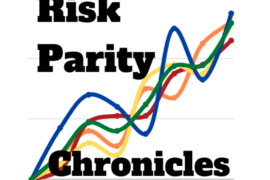It’s always great to connect with other investors that share some of the same interests and passions.
Thus, I’m thrilled to welcome Jason Allgyer to the “How I Invest” series.
From living abroad to collecting baseball cards as a kid, it seems we have more in common aside from just pursuing the best versions of our portfolios.
Two investing rabbit holes I could infinitely fall down are multifactor investing strategies and capital efficient asset allocation.
Factor investing can involve keying in on single factors such as value, momentum, quality, yield and/or minimum volatility.
However, a multifactor approach may be the most prudent way for most investors to gain factor exposure.
Hence, we’ll specifically be keying in on a multifactor investing approach with this interview.
Additionally, when it comes to capital efficient asset allocation, we have a number of competing terms being tossed into the ring for consideration these days.
Efficient core.
My contribution is Expanded Canvas Portfolios.
What ties them altogether is the thoughtful expansion of the portfolio to create more space for two or more asset classes.
Well now that we’ve teed things up let’s turn it over to Jason.

Capital Efficient Asset Allocation and Multifactor Investing: How I Invest with Jason Allgyer

Hey guys! Here is the part where I mention I’m a travel content creator! This “How I Invest” interview is entirely for entertainment purposes only. There could be considerable errors in the data I gathered. This is not financial advice. Do your own due diligence and research. Consult with a financial advisor.

These asset allocation ideas and model portfolios presented herein are purely for entertainment purposes only. This is NOT investment advice. These models are hypothetical and are intended to provide general information about potential ways to organize a portfolio based on theoretical scenarios and assumptions. They do not take into account the investment objectives, financial situation/goals, risk tolerance and/or specific needs of any particular individual.
Tyranny Of Compounding Costs = Crucial For DIY Investors To Understand
Who were your greatest influences as an investor when you first started to get passionate about the subject?
How have your views evolved over the years to where you currently stand?
If you had to recommend a handful of resources (books, podcasts, white-papers, etc) to bring others up to speed with your investing worldview what would you recommend?
Jack Bogle was the first great influence on me.
The tyranny of compounding costs is a table stakes concept for any DIY investor to understand.
Warren Buffet’s letters guided me to Ben Graham.
At that time the Bogleheads were hosting a 15 round heavyweight fight between Rick Ferry and Larry Swedroe.
Larry won the debate.
I got to benefit.
Since then I’ve gotten into works from Cliff Asness, Wes Grey, Jack Vogel, Corey Hoffstein and others.

Baseball Cards Taught Me About Asset Class Bubbles and Liquidity Risk
Aside from investing influences, what real life events have molded your overall views as an investor?
Was it something to do with the way you grew up?
Taking on too much risk (or not enough) early on in your journey/career as an investor?
Or just any other life event or personality trait/characteristic that you feel has uniquely shaped the way you currently view yourself as an investor.
Education.
Travel.
Work Experience.
Volunteering.
A major life event.
What has helped shape the type of investor you’ve become today?

I’ve been interested in investing since I was a child.
I started in the 90s in baseball cards – some of which I still own.
It was also my first lesson in asset bubbles and liquidity risk.
In the late 90’s I opened my first brokerage account and promptly lost my $2k investment.
After two flops in a row I knew I needed to get serious about education.
I also knew that “get rich fast” was a sure way to lose all your money.
So, I googled “get rich slowly” – which fortunately was also the name of a value investing forum at that time.
It was in this forum that I was introduced to Bogleheads.
I spent a few years at Bogleheads.
I found Bogleheads to be wise, but not smart.
Eventually I outgrew them and their dogmatic approach.
That was fortunate for me as I have been able to significantly outperform their recommended index portfolios over the last 15 years.

Expanding Your Comfort Zone Does Not Mean Taking Uninformed Risks
Imagine you could have a three hour conversation with your younger self.
What would you tell the younger version of yourself in order to become a better investor?
Something that you know now that you wish you knew back then.
Investing is emotionally difficult.
Like most challenging things in life you need to keep on expanding your comfort zone, else you run the risk of your comfort zone shrinking over time.
That receding level of comfort can leave people exposed to damaging decisions when their once safe portfolio triggers irrational fear within them.
Expanding your comfort zone does not mean taking uninformed risks.
But it does recognize that there are always risks.
There is no safe harbor.
And there are strategies you can employ to put the odds of surviving risks without emotional errors in your favor.
I firmly believe that investors that lose money early in their investing life are MUCH better investors by the time they hit middle age than those who paint within the lines and dedicate themselves to a dogma.

I Have A High Risk Tolerance That Has Been Tested And Proven Many Times
Let’s pop the hood of your portfolio.
What kind of goodies do we have inside to showcase?
Spill the beans.
How much do you got of this?
Why did you decide to add a bit of that?
If you’d like to go over every line-item you can or if would be easier to break your portfolio into categories or quadrants that’s another route worth considering.
When do you anticipate this portfolio performing at its best?
The preface.
I am 1/2 way through my career.
Well ahead of all savings goals.
I have a high risk tolerance that has been tested and proven many times.
I am also influenced by having permanent employment – which is basically a job guarantee similar to a tenured professor.
I’d have to really screw up to lose my job and even if I do, I can find a new job in my profession within a month.
I’ve proven that as two previous startups I worked for went under suddenly.
I have two separate allocations because of tax efficiency.
They roll up to a 100/60/10 Equity/Short Term Bond/Long term bond notional exposure.
In my IRA I am 100% PIMCO StockPlus.
95% is in the RAE flavor which gets me good multi-factor equity exposure + bond alpha as an overlay.
5% in StockPlus Long Duration.
The rationale is simple.
Take a 50/50 Equity/Bond portfolio and lever it up 2x.
Return Stacking – although the lack of Managed Futures may get me in trouble with Corey Hoffstein for calling it that.
My timeline for using these funds is 15+ years.
As I get closer to wanting to retire I’ll take the sizeable annual distributions and layer those into a short term bond fund & possibly TIPS ladder.
I entered into this portfolio in September.
Previously the IRA avoided bonds and invested 100% in global multi-factor
In taxable I am 100% equities in a 70/20/10.
70% Avantis multifactor.
10% BAB.
Overall I am ~70% international and 30% US.
A high split relative to most recommended allocations.
But I am an ExPat.
My expenses are in Euro’s while my assets are in dollars.
I like the natural hedge of having my productive assets earn in non-dollar terms.
I also believe International is ripe for a reversion to the mean from these valuations.
Beyond that I keep 6 months expenses in cash.

Learning That Factors Diversify My Sources Of Risk
What kind of investing skills (trading, asset allocation, investor psychology, etc) are necessary to become good at the style of investing you’re pursuing?
Is there a certain type of knowledge, experience and/or personality trait that gives one an advantage running this type of portfolio?

I don’t recommend anyone do what I did.
From 2001 – 2010 I was 70/30 Beta/Bonds.
Then I switched to 70/30 Beta/Multifactor from 2010 – 2015 because I wanted to add risk/return at what I saw as a generational bottom.
Then to 100% Beta from 2015 – 3/23/2020 because I won the previous bet.
At the time I mistakenly thought that I had gambled on factors, they put me ahead of the game, now let’s take the chips off the table and ride beta to the finish line.
My biggest mistake at that time was thinking of factors as increasing risk rather than diversifying my sources of risk.
When the Covid crash happened I moved back to 100% multifactor.
Only this time with a deeper understanding of factors as unique sources of risk and an appreciation that beta-only strategies were “putting all my eggs in one basket.”
I’ve been in the allocation above since September of this year.
NO ONE should be following me.
This is a lot of tactical turnover.
But it also expanded my comfort zone and gave me the education and conviction for my portfolio today.

Waiting For The Mania Surrounding Managed Futures To Dissipate
What would be a toned down version of your portfolio?
Something that’s a bit watered down.
Conversely, what would be a more aggressive version of your portfolio, if someone were willing to take on more risk for a potentially greater reward?
To tone it down there are two options.
1) Reduce leverage.
2) Tilt more towards short term bonds.
More aggressive?
I’m at about 170% overall notional exposure.
I’m guessing you could get away with 200%, maybe 220%, because of the large amount of short term bond exposure.
There also could be a role for Managed Futures using Trend.
I have that on my watchlist and am waiting for the mania around them to dissipate before I really evaluate my emotional readiness to hold them for the long term.

My Greatest Strengths: Contrarian Nature and Emotional Fortitude
What do you feel is your greatest strength as an investor?
What is something that sets you apart from others?
Conversely, what is your greatest weakness?
Are you currently trying to address this weakness, prevent it from easily manifesting or simply doubling down on what it is that you’re great at?
My greatest strengths are my contrarian nature and my emotional fortitude.
I’ve always been able to be greedy when there is blood in the streets.
It’s how I am wired.
That’s also my greatest weakness.
Differentiating between “cheap for a reason” and “cheap in spite of reason” has been a struggle.
I want to drive towards the train wreck.
And sometimes driving around it would be faster, easier, and more effective.

I Believe That I Can Out Grow Risk By Getting Ahead To Stay Ahead
What’s something that you believe as an investor that is not widely agreed upon by the investing community at large?
On the other hand, what is a commonly held investing belief that most in the industry would agree with that rubs you a bit differently?

I believe that I can out grow risk.
Much of the investing community is about managing volatility through mean variance optimization.
Volatility doesn’t matter if you have $1b.
It won’t impact your life.
So a lot of my focus has been to get ahead and stay ahead.
Stretch the lead.
Hit 3x my number before I want to retire and volatility can’t touch me.
It’s the Bill Bernstein’s deep vs shallow risk.
The commonly held belief that irks me is this fascination the market has with extrinsic value.
“It’s disruptive!”
“You don’t get it.”
“Its going to change the world.”
There is so much marketing and spin in this world that captures people and makes them believe.
Crypto cult.
ARKK.
Etc.
I don’t think your average investor should be investing in disruption without intrinsic value as part of the package.
Disruption in extrinsic packaging should be for those who can afford to lose their entire investment.
Not your 401k.

Keen To Learn More About Managed Futures
What’s a subject area in investing that you’re eager to learn more about?
And why?
If you knew more about that particular topic would it influence the way you’d construct your portfolio?
Yeah, I know.
It’s getting a lot of attention for all the wrong reasons.
It’s had great recent performance.
I like it from a mean variance perspective.
My hangup, and it’s a big one, is that the underlying are a non-productive set of assets.
There is no cash flow associated with them.
I am trying to wrap my head around the value an investor brings to these markets by participating.
There is risk, but is it zero sum risk less frictional costs?
That’s a game I don’t think I want to play.
At the same time, risk is transformed in these markets.
So there is a case to be made that the assumption of risk provides valuable service that can be reliably compensated – in spite of the underlying assets being non productive (crude sludge, tons of steel collecting dust) I don’t have my head wrapped around that.

50% Crypto and 50% ARKK Portfolio Is Repulsive
What would be the ultimate anti-Jason Allgyer portfolio?
Something you’d never own unless you were duct-taped to a chair as a hostage?
What about this portfolio is repulsive to you?
Conversely, if you were forced to Steel Man it, what would potentially be appealing about the portfolio to others?
What is so alluring about it?
50% Crypto / 50% ARKK.
It’s repulsive to me.
Nearly all extrinsic value.
I get why people do it.
It MOVES!
But even if I could (I never will) get over the heavyweight extrinsic nature of the valuations, I’d still have to be right twice (buy and sell) and overcome high frictional costs to make it worth while.
Just darn ugly.
And frankly stupid.
Connect With Jason Allgyer
You can follow Jason Allgyer on Twitter @expatforfreedom.
Nomadic Samuel Final Thoughts
I want to personally thank Jason for taking the time to participate in the “How I Invest” series by contributing thoughtful answers to all of the questions!
If you’ve read this article and would like to be a part of the interview series feel free to reach out to nomadicsamuel at gmail dot com.
That’s all I’ve got!
Ciao for now!
Important Information
Investment Disclaimer: The content provided here is for informational purposes only and does not constitute financial, investment, tax or professional advice. Investments carry risks and are not guaranteed; errors in data may occur. Past performance, including backtest results, does not guarantee future outcomes. Please note that indexes are benchmarks and not directly investable. All examples are purely hypothetical. Do your own due diligence. You should conduct your own research and consult a professional advisor before making investment decisions.
“Picture Perfect Portfolios” does not endorse or guarantee the accuracy of the information in this post and is not responsible for any financial losses or damages incurred from relying on this information. Investing involves the risk of loss and is not suitable for all investors. When it comes to capital efficiency, using leverage (or leveraged products) in investing amplifies both potential gains and losses, making it possible to lose more than your initial investment. It involves higher risk and costs, including possible margin calls and interest expenses, which can adversely affect your financial condition. The views and opinions expressed in this post are solely those of the author and do not necessarily reflect the official policy or position of anyone else. You can read my complete disclaimer here.







I enjoyed the article and also use the Pimco fund PSLDX for my Ira. Which fund do you use for PIMCO StockPlus?